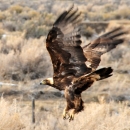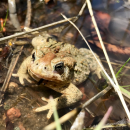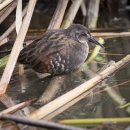About Us
The name Seedskadee originated from local tribes' word "Sisk-a-dee-agie" meaning "river of the prairie hen." The 26,210 acre Refuge protects a mosaic of riparian riparian
Definition of riparian habitat or riparian areas.
Learn more about riparian , wetland, and upland shrub habitats along 36 miles of the Green River in southwest Wyoming. The riparian corridor of the Green River is an important migration route and nesting area for a wide variety of migratory waterfowl and passerine bird species. Many insects, big game and small mammals can be found on the Refuge as well as resident and migratory birds. Refuge lands are also rich in historic and cultural resources. The area was used by nomadic Indian tribes, fur trappers, and early pioneers. Thousands of pioneers crossed the treacherous Green River on what is now Seedskadee National Wildlife Refuge. The Oregon, Mormon, and California Trails, as well as the Pony Express Route, which all cross the refuge, have been designated as National Historic Trails by Congress. Jim Bridger and others operated ferries on the Green In the 1840's and 1850's. Diaries of immigrants often mention the crossing on the river and its difficulties. Ferries were swept away by the strong currents and lives and possessions were lost. To this day, some of the trails can be traced across the Refuge by their ruts.
Seedskadee is a unique and important component of the National Wildlife Refuge System (System) which includes more than 565 refuges totaling over 93 million acres across the United States. Seedskadee National Wildlife Refuge was established in 1965 through the Colorado River Storage Project Act of 1956. Section 8 of this Act provided for the establishment of wildlife habitat development areas to offset the loss of wildlife habitat resulting from reservoir development in the Colorado River Drainage. The Seedskadee Reclamation Act of 1958 specifically authorized acquisition of lands for Seedskadee National Wildlife Refuge. In 1997, Congress passed the National Wildlife Refuge System Improvement Act. This Act required development of a Comprehensive Conservation Plan (CCP) for each refuge and that management of each refuge be consistent with the CCP. In addition, the Improvement Act required that each refuge be managed to fulfill the mission of the National Wildlife Refuge System as well as the specific purposes for which each refuge was established.
Seedskadee National Wildlife Refuge's purpose is defined by two pieces of Federal enabling legislation. The principal purpose of Seedskadee National Wildlife Refuge is to provide for the conservation, maintenance, and management of wildlife resources and its habitat including the development and improvement of such wildlife resources. Additionally, the Refuge is charged to protect the scenery, cultural resources, and other natural resources and provide for public use and enjoyment of compatible wildlife-dependent activities.
The two pieces of enabling legislation are:
1. Fish and Wildlife Coordination Act: “. . . shall be administered by him/her (Secretary of the Interior) directly or in accordance with cooperative agreements . . . and in accordance with such rules and regulations for the conservation, maintenance and management of wildlife, resources thereof, and its habitat thereon, ” 16 U.S.C. 664
2. Colorado River Storage Act (section 8): “In connection with the development of the Colorado River Storage Project (CRSP) and of the participating projects, the Secretary is authorized and directed to investigate, plan, construct, operate, and maintain . . . (1) public recreational facilities on lands withdrawn or acquired . . .” for the Colorado River Storage Project or participating projects in order to “. . . conserve the scenery, the natural, historic, and archaeologic objects, and the wildlife on said lands, and to provide for public use and enjoyment of the same and of the water areas created by these projects by such means as are consistent with primary purposes of said projects . . . and (2) facilities to mitigate losses of and improve conditions for, the propagation of fish and wildlife.” The Secretary may “. . . dispose of . . .” the facilities “. . . to Federal . . . agencies . . . upon such terms and conditions as will best promote their development and operation in the public interest.” 43 U.S.C. 620g Besides these two pieces of enabling legislation, the thirty-fifth legislature of the State of Wyoming passed enrolled Act No. 54 in 1959 “providing consent of the State of Wyoming to the acquisition by the United States where approved by the Wyoming Game and Fish Commission and the State Land Board, of lands for the establishment of migratory bird refuges.” In the Act, the State of Wyoming has consented to the acquisition of up to 20,000 acres of land in Wyoming for the establishment and maintenance of migratory bird refuges in accordance with and for the purposes of the Migratory Bird Conservation Act and the Migratory Bird Hunting Stamp Act.
Thus, if ever any of these authorities, and associated funds, were invoked for the acquisition of new lands for Seedskadee National Wildlife Refuge, these lands would be managed for “use as an inviolate sanctuary, or for any other management purpose, for migratory birds” (16 U.S.C. 715d) in accordance with the Migratory Bird Conservation Act. To date, all lands acquired have been through Section 8 of the 1956 Colorado River Storage Project Act and, as such, shall be managed under.
Our Mission
The mission of the National Wildlife Refuge System is to administer a national network of lands and waters for the conservation, management and, where appropriate, restoration of the fish, wildlife and plant resources and their habitats within the United States for the benefit of present and future generations of Americans.
Our History
Historical Perspective
The first recorded humans in this area arrived when continental ice sheets receded to the north. They were followed by the Shoshone peoples who began arriving in this area approximately 700 years ago. Both groups were nomadic, largely dependent on buffalo and antelope herds that migrated through the area.
The early 1800s marked the arrival of the first European trappers to this area in search of beaver to trap. These rugged mountain men, including Jedediah Smith, Jim Bridger, and William Sublette, crossed the Green River where Seedskadee National Wildlife Refuge is now located.
Beginning in 1841, many emigrants followed in these trappers’ footsteps. The much traveled Oregon, Mormon, California, and Pony Express trails all cross the Refuge. Segments of these trails can still be seen on and adjacent to the Refuge.
With the arrival of the railroad in 1868, stockmen began to settle in the area. Intensive livestock grazing in the late 1800s caused deterioration of the range and habitat conditions. As the new century began, homesteaders also made their mark on the land. Some of the structures they built, now considered national historical sites, can still be seen on the Refuge. For more in-depth historical information of these sites, pick up our historical brochure at the Refuge headquarters.
Historical Quotes
On the 16th we frequently encountered snow. There were large beds of it on the summit and slopes of the mountains visible to the north. We halted beside the Spanish River [Green River], a large stream on whose banks, according to some Indians, the Spanish live. It flows west and, it may be supposed, empties into the Gulf of California. We were surrounded by mountains in which we found beautiful green meadows where many herds of buffalo graze - a fact the more interesting to us because we had not seen a single one of these animals for several days. I found three different species of gooseberries: the common type with red berries, low bushes, and very spiny stems; a second with excellent yellow berries and non-spiny stems; and a third with dark red berries that taste much like our winter grapes. It is nearly as large and has very spiny stems. I also saw three kinds of currants; one has red berries, large and savory, with bushes eight or nine feet high; another with yellow berries about the size of ordinary currants, and with bushes about four or five feet high; and a third with bright red berries that are almost as sweet as strawberries but are rather insipid. Their bushes are small. (20 miles) On the 17th we continued to follow the river to the opposite end of the mountains. Beaver and otter seemed to be everywhere. In fact, for some distance down the mountainside the area appears to be very favorable for trapping beaver. Ducks and geese are also plentiful.
-Wilson Price Hunt 1812
Sunday 19th We left the creek which turned South traveled west 6 miles over a broken sandy country & came to the Shetkadee which bS S.E. & N W runs S E - is one hundred yards wide 4 to five feet deep with a rapid current - mountains bS N & westerly about 15 or 20 miles - And a range of mountains at a great distance say 40 or 50 miles southwardly - pleasant weather - game scarce Some fresh sign of beaver on this river and much old sign - timbered with long leaf cotton wood & small willow – Thursday 23rd our boat answers the desired purpose greatly beyond my expectation it is Easily navigated & Carries as much again as I expected we decended the River to day about 3 [sic] miles 10 miles of which The river ran E. S. E. to a small Creek 30 yds wide 20 S E - high broken country on Each side the bodirs of the river Wooded with Cotton wood & willow ...
-William H. Ashley 1825
Green River Rendevouz
June 19th. We arrived to-day on the Green river, Siskadee or Colorado of the west, a beautiful, clear, deep, and rapid stream, which receives the waters of Sandy, and encamped upon its eastern bank. After making a hasty meal, as it was yet early in the day, I sallied forth with my gun, and roamed about the neighborhood for several hours in quest of birds. On returning, towards evening, I found that the whole company had left the spot, the place being occupied only by a few hungry wolves, ravens, and magpies, the invariable gleaners of a forsaken camp. …… Captain W. explained to me that he had heard of good pasture here, and had concluded to move immediately, on account of the horses; he informed me, also, that he had crossed the stream about fifty yards below the point where I had entered, and had found an excellent ford.
30th. Our camp here is a most lovely one in every respect, and as several days have elapsed since we came, and I am convalescent, I can roam about the country a little and enjoy it. The pasture is rich and very abundant, and it does our hearts good to witness the satisfaction and comfort of our poor jaded horses. Our tents are pitched in a pretty little valley or indentation in the plain, surrounded on all sides by low bluffs of yellow clay. Near us flows the clear deep water of the Siskadee, and beyond, on every side, is a wide and level prairie, interrupted only by some gigantic peaks of mountains and conical butes in the distance. The river, here, contains a great number of large trout, some grayling, and a small narrow-mouthed white fish, resembling a herring. They are all frequently taken with the hook, and, the trout particularly, afford excellent sport to the lovers of angling. Old Izaac Walton would be in his glory here, and the precautionary measures which he so strongly recommends in approaching a trout stream, he would not need to practise, as the fish is not shy, and bites quickly and eagerly at a grasshopper or minnow.
Buffalo, antelopes, and elk are abundant in the vicinity, and we are therefore living well. We have seen also another kind of game, a beautiful bird, the size of a half grown turkey, called the cock of the plains, (Tetrao urophasianus.) We first met with this noble bird on the plains, about two days' journey east of Green river, in flocks, or packs, of fifteen or twenty, and so exceedingly tame as to allow an approach to within a few feet, running before our horses like domestic fowls, and not unfrequently hopping under their bellies, while the men amused themselves by striking out their feathers with their riding whips. When we first saw them, the temptation to shoot was irresistible; the guns were cracking all around us, and the poor grouse falling in every direction; but what was our disappointment, when, upon roasting them nicely before the fire, we found them so strong and bitter as not to be eatable. From this time the cock of the plains was allowed to roam free and unmolested, and as he has failed to please our palates, we are content to admire the beauty of his plumage, and the grace and spirit of his attitudes.
-John Kirk Townsend 1839
In the spring of 1837, I went to the Rocky Mountains with a few companions, trapping on the way, selling pelts to Bridger at Green river. One is a branch of the "American Fur Company," under the direction of Mess Dripps and Fontanell: The other is called the "Rocky Mountain Fur Company" The names of the partners are Thomas Fitzpatrick, Milton Sublett and James Bridger. The two companies consist of about six hundred men...This stream is called Ham's fork of Green River. The face of the adjacent country is very mountaneous and broken except in the small alluvial bottoms along the streams, it abounds with Buffaloe, Antelope, Elk and Bear, and some few Deer along the Rivers. Here Mr Wyeth disposed of a part of his loads to the Rocky Mountain Fur Company and on on the 2d of July we renewed our march towards the Columbia River. After leaving Ham's Fork we took across a high range of hills in a NW direction and fell on to a stream called Bear River which emptied to the Big Salt Lake. This is a beautiful country. the river which is about 20 yards wide runs through large fertile bottoms bordered by rolling ridges which gradually ascended on each side of the river to the high ranges of dark and lofty mountains upon whose tops the snow remains nearly the year round. We travelled down this river N West about 15 miles and camped opposite a Lake of fresh water about 60 miles in circumference which outlets into the river on the west side.
From Journal of a Trapper by Osborne Russell
Other Facilities in this Complex
Seedskadee National Wildlife Refuge is managed as part of the Central Sage Steppe Conservation Complex. A Conservation Complex is a group of two or more refuges, wildlife management areas, wetland management districts, or conservation areas that are primarily managed from a central office location. Refuges are grouped into a complex because they occur in a similar region, such as a watershed or specific habitat type, and have a related purpose and management needs. Typically, a project leader oversees the management of the refuges within the complex and refuge managers are responsible for operations at specific refuges. Support staff: administrative, law enforcement, refuge manager, biological, fire, visitor services, and maintenance, are centrally located and help with all refuges within the complex.
Other refuges in the Central Sage Steppe Conservation Complex include: Cokeville Meadows National Wildlife Refuge; Wyoming's portion of the Bear River Watershed Conservation Area; Pathfinder National Wildlife Refuge - near Casper; four refuges on the Laramie Plains: Bamforth National Wildlife Refuge, Hutton Lake National Wildlife Refuge, Mortenson Lake National Wildlife Refuge and the Wyoming Toad Conservation Area; and Arapaho National Wildlife Refuge near Walden in Northwestern Colorado. Administrative headquarters for the southwestern Wyoming refuges is located at Seedskadee National Wildlife Refuge, 37 miles north of Green River on Hwy 372 - 246 Seedskadee Road, PO Box 700, Green River, WY 82935; phone number 307-875-2187. Administrative headquarters for Arapaho, Pathfinder, and the Laramie Plains refuges is located at Arapaho National Wildlife Refuge, in Walden, CO phone number 970-732-8202.






